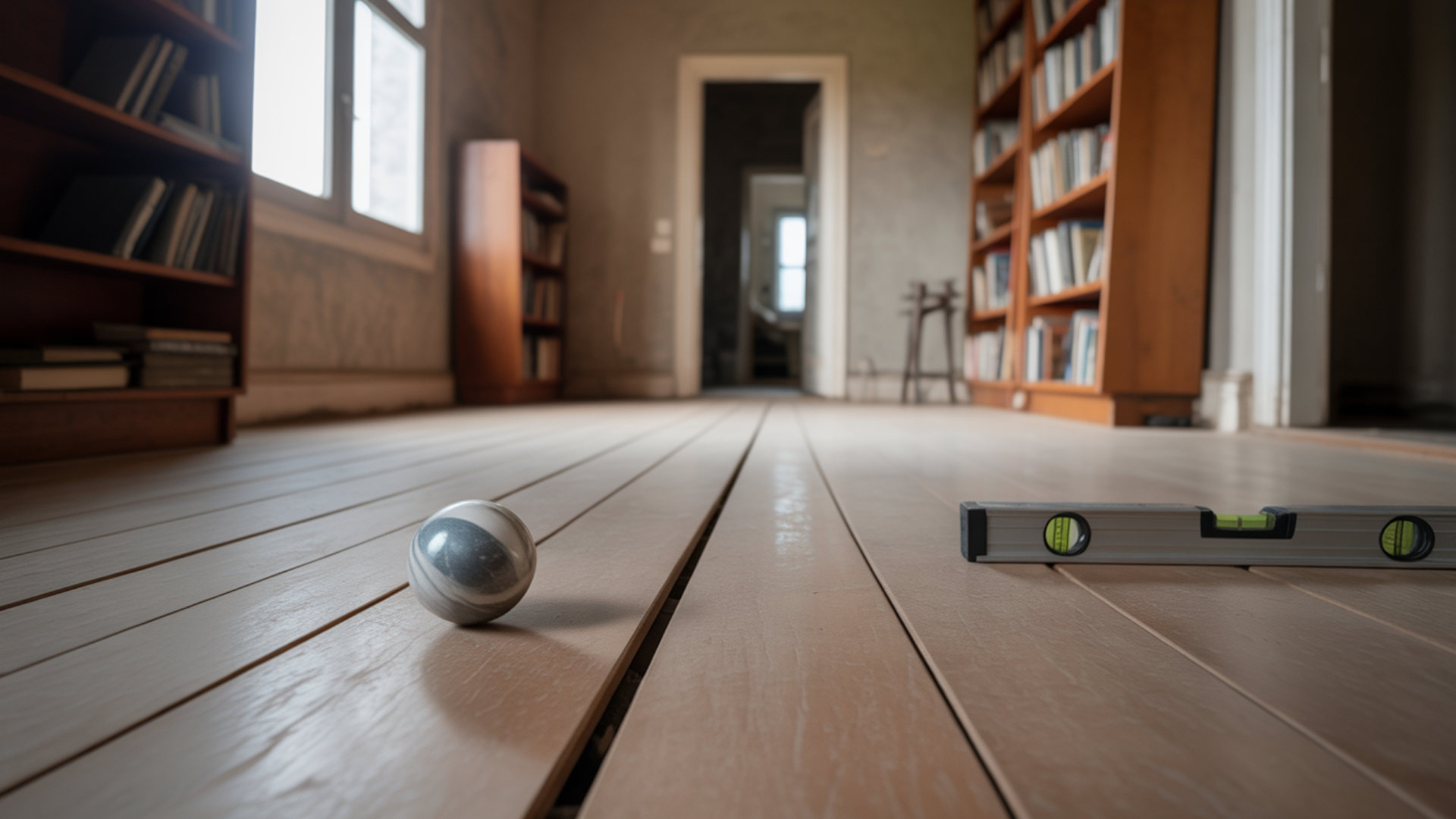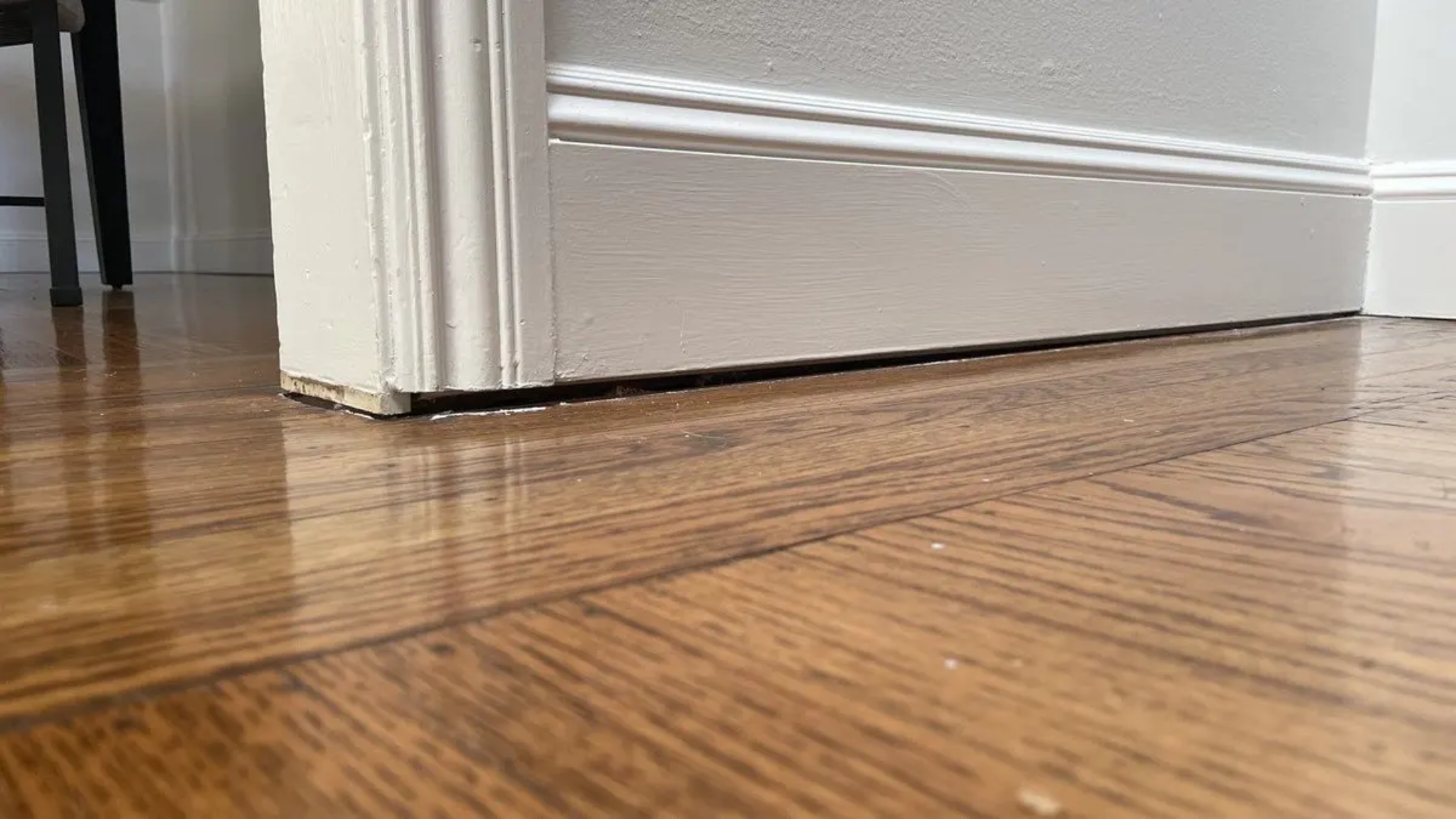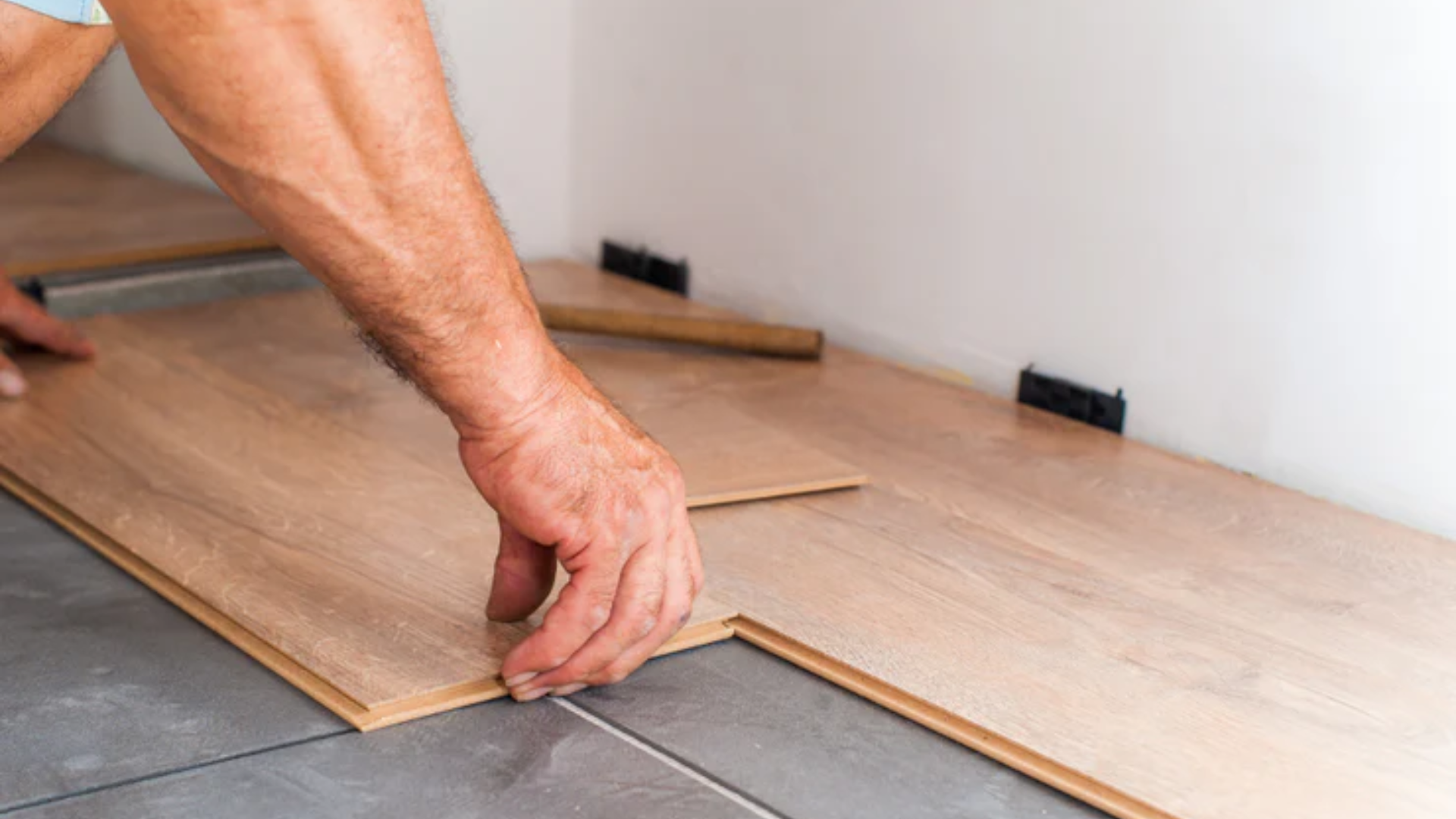Uneven floors are a common issue I’ve come across in many homes.
When I walk through a room and feel the floor sloping, sagging, or even bouncing, it’s not just uncomfortable, it can feel unsafe too. But the good news is, there are practical ways to fix it.
In this guide, I’ll explain what causes uneven floors, how to spot the signs, and what steps you can take to fix the problem correctly.
No matter how big or small the issue is, you’ll know what to do next.
If your floors are sloping or sinking, I get that you want real solutions, not vague ideas. That’s why this article focuses on clear, helpful advice that actually works.
I’ve written everything in plain, simple language so it’s easy to follow. You don’t need to be an expert to understand or apply what’s here.
If you searched for help with uneven floors, you’re in the right place. This post is all about fixing the real problems, not just covering them up.
What Causes Uneven Floors?

Uneven floors often signal deeper issues beneath the surface. These dips or slopes may begin subtly but tend to worsen over time.
It may feel like the floor is sinking in certain areas or slanting off to one side.
While some causes are relatively minor and easy to correct, others require more substantial intervention.
Understanding the most common reasons can help you identify the problem and plan for appropriate repairs.
- Settling foundation: When the ground under the house shifts or sinks, the foundation settles unevenly, causing parts of the floor to dip or rise.
- Broken or weak floor joists: Joists hold up the floor. If they crack, bend, or break, they can’t support weight evenly, leading to sloping or bouncy areas.
- Water damage or moisture: Moisture can rot wood or soften subfloor materials. Over time, this weakens the structure and causes uneven spots.
- Termite or mold damage: Termites eat through wood, and mold breaks it down. Both can cause joists or subfloors to fail and floors to sag.
- Poor construction from the start: If the floor wasn’t built level or strong in the first place, problems show up later. Mistakes during building can lead to long-term unevenness.
What Is a Slanting or Sloping Floor?

A slanting or sloping floor is when the entire surface tilts in one consistent direction. Walking on it may feel like walking slightly uphill or downhill.
This type of unevenness affects the whole floor area, not just one part.
A noticeable slope often points to a deeper issue, usually related to the home’s foundation.
As the foundation settles, shifts, or becomes unstable, often due to soil movement, water damage, or poor construction, the floor above begins to tilt.
Over time, this can lead to visible signs like furniture sliding on its own, marbles rolling without a push, or doors that no longer close properly.
Cracks may also form in the walls or ceiling as the house structure adjusts to the uneven base.
It’s important to check for these signs early and call a professional, since sloping floors can indicate serious structural problems.
These problems look alike but aren’t the same. They result from different issues, which means they also need other repairs. Let’s break it down.
| Slanting/Sloping Floor | Sagging Floor |
|---|---|
| The floor tilts in one direction | Floor dips or sinks in the middle |
| Caused by foundation issues or soil movement | Caused by weak, damaged, or rotted joists |
| The whole floor is angled | Only part of the floor sinks |
| Common signs: furniture slides, uneven tilt | Common sign: floor feels soft or bouncy |
| Fixed by foundation repair | Fixed by reinforcing or replacing joists |
How to Spot Uneven Floors

Uneven floors may signal underlying issues with your home’s structure or foundation. Catching these signs early can help you avoid more serious and expensive repairs later on.
How to recognize and check for floor irregularities:
Signs to Look For
Uneven floors can reveal themselves in several subtle but telling ways.
Noticing and interpreting these signs early can be key to addressing problems before they become more severe.
- Bouncy or Sloping Floors: If the floor feels springy when you walk across it or clearly slopes in specific areas, it could indicate a structural issue beneath the surface.
- Sticky or Self-Opening Doors: Doors that drag, stick, or swing open or closed without being touched may reflect movement in the frame caused by a shifting floor.
- Wobbly or Leaning Furniture: When furniture tilts or rocks despite being placed on what appears to be a flat area, it may be reacting to an uneven floor.
- Gaps Under Baseboards or Walls: Look along the edges where the floor meets the walls or baseboards. Gaps or separations in these areas can suggest shifting or sagging.
How to Check for Uneven Floors
There are a few practical methods to assess whether your floor is level.
These simple checks can provide a strong indication of whether further inspection or professional evaluation is needed.
- Use a Level: Place a bubble or laser level on various parts of the floor. If the bubble isn’t centered, there’s likely a slope.
- Mark High and Low Points: Using masking tape or a pencil, mark the spots where the floor dips or rises. This gives a clearer picture of the affected areas.
- Observe Surroundings: Watch how windows and doors behave and whether furniture sits flush with the walls. These subtle signs often point to shifts in the flooring.
Basic Tools & Materials
Before starting any subfloor or flooring project, it’s important to have the right tools ready. These help with measuring, leveling, removing old materials, and handling tasks safely and efficiently.
- Level (bubble or laser)
- Chalk or Painter’s Tape
- Hammer and Nails
- Pry Bar
- Measuring Tape
- Safety Gear
Along with your tools, you’ll need materials to fix, strengthen, and level your subfloor. These items help create a firm, flat base that supports the flooring type you choose.
- Self-Leveling Compound
- Shims
- Plywood Sheets
- Joist Hangers or New Wood
- Floor jacks
Fixing a Floor That Slopes or Tilts

Some floors tilt or dip due to age or foundational issues, while others slope because of moisture problems or substandard construction.
You can address small slopes on your own, while larger issues may require a professional. It’s crucial to fix the root cause, not just the surface appearance.
Patience is essential. Raise floors gradually, never all at once.
Attempting a fast fix can result in cracked drywall, broken tiles, or plumbing issues. Slow, steady adjustments give the structure time to stabilize.
DIY Solutions for Minor Slopes
Minor slopes, those less than 1 inch, are simpler to handle and can be repaired on concrete or wooden subfloors with the following methods:
- Self-Leveling Compound: This compound is ideal for filling in low spots on concrete or plywood. Pour the compound, allow it to settle, and follow the manufacturer’s directions precisely.
- Sleepers (Wood Strips): Place thin wood strips in the lower areas to create a level base for new flooring. Make sure they are firmly secured to prevent movement.
- Add Plywood Over Sleepers: Install plywood sheets on top of the sleepers and fasten them tightly with nails or screws. This forms a smooth, even subfloor ready for installation of the final flooring material.
Addressing More Significant Slopes
If your floor drops more than 1–2 inches, this may indicate structural problems such as sagging supports or weakened framing. These methods should be approached cautiously:
- Floor Jacks: Use jacks to raise the lower portion of the floor slowly. Do not lift more than ¼ inch per day to avoid damaging walls, pipes, or finishes.
- Add Support Beams: After lifting, install additional beams beneath the area to provide ongoing structural support and prevent further sinking.
- Reinforce Joists: Secure new joists alongside existing ones to strengthen the floor frame and help correct any warping.
Fixing a Sagging Floor

Sagging floors are often caused by weak or damaged supports underneath. If not fixed, the problem can get worse over time.
Start by figuring out where the floor dips. Then take steps to lift and support it properly.
- Find the Lowest Point: Use a level or a long, straight board to check the floor. Move it around the room and mark the areas where the floor dips the most. This will show you where the sag is happening and help you plan repairs.
- Check the Floor Joists: Go under the floor to look at the joists, which are the horizontal beams that hold up the floor. Look for signs of damage, such as cracks, sagging, water stains, rot, or mold.
- Use Floor Jacks and Support Beams: Place a solid beam under the sagging area. Then, set up floor jacks under the beam. Slowly raise the jacks a little each day until the floor is level.
- Sistering the Floor Joists: Sistering means attaching a new board to the side of a damaged joist. Cut a new piece of lumber that matches the size of the old one. Place it next to the weak joist and fasten it tightly with screws and construction adhesive.
- Reinforce the Subfloor: Once the joists are solid, check the subfloor. If it feels soft or weak, add a layer of plywood on top to strengthen it. You can also insert short blocks of wood between the joists to keep them from shifting.
How to Fix Uneven Floors in Old Houses
Uneven floors are common in older homes. Some tilt to one side, and others sink or dip in spots. This is not just annoying; it might mean something is wrong underneath.
To fix the problem, you need to understand what’s causing it. Sometimes it’s just because the house is old. Other times, it could be from damage or weak support.
Why Old Homes Have Uneven Floors
Many older homes were built 50, 75, or even over 100 years ago. Time causes wear and tear on materials, especially under the floor. Some common causes are:
- Settling over time: The ground under the house can shift. When the soil moves, parts of the house sink more than others, making the floor uneven.
- Weakened support beams and floorboards: Wood parts under the floor can bend or shrink, and nails may loosen or rust. Over time, this causes dipping or sagging.
- Water or insect damage: Leaks from pipes or roofs can rot wood. Insects like termites eat through beams. When the structure weakens, floors lose strength.
How to Repair Uneven Floors
To fix the floor, you usually have to start underneath. Just putting new boards on top won’t solve the real issue. Here are a few ways that often work:
- Use floor jacks to lift the beams gradually: Raise the sagging area slowly. If you do it too fast, you could cause cracks in walls or ceilings.
- Add extra support with new wood: A method called sistering involves placing a new joist next to an old one and fastening them together, strengthening the floor.
- Put in a new subfloor if needed: If the layer under the floorboards is badly damaged, it’s best to replace it. Strong plywood or OSB panels work well.
- Ask a professional if the problem is big. If your floor slopes a lot or feels bouncy, it could be a deeper issue. A building expert can examine the foundation or main supports.
Preventing Future Problems
Uneven floors are common in older homes. Some slopes, and others sag or dip in certain areas. It’s not just annoying; it could mean bigger issues.
Fixing them the right way means understanding why it’s happening. Sometimes, it’s just age. Other times, it’s structural. Let’s break it down.
- Fix leaks quickly: Leaks from pipes, toilets, or roofs can slowly damage the wood beneath your floors. Even a small drip, if left alone, can lead to rot or mold.
- Control moisture: Too much moisture in the air can weaken the wood under your floors and attract bugs. To prevent this, use fans when cooking or showering.
- Don’t overload the floor: Heavy furniture or stacked boxes can press down too hard on old floors. This extra weight may cause boards to bend or crack.
- Check crawl spaces and basements: These areas are easy to forget, but they matter a lot. Problems often start under the house. Once a year, use a flashlight to look for wet spots, sagging beams, or signs of pests like termites.
- Watch for new cracks or slopes: Pay attention to changes in your home. If the floor starts sloping more than before, or you notice new cracks in the walls or floor, something might be shifting. Doors that stop closing properly can also be a clue.
Conclusion
Uneven floors in older homes aren’t always a major concern, but they should never be overlooked.
Often, the cause is something minor, like natural settling or age-related wear. In other cases, it could signal a more serious issue, such as water damage or a compromised foundation.
Before starting any repairs, it’s important to understand the underlying cause. Some fixes are manageable with basic tools, such as adding support or replacing subfloor sections.
But if you see significant gaps, deep dips, or doors that won’t close properly, it’s best to consult a professional.
A structural expert can identify risks that might not be obvious at first glance.
Keeping your floors level not only improves your home’s comfort but also helps preserve its structural integrity.
Addressing problems early can prevent bigger expenses and complications down the line.

